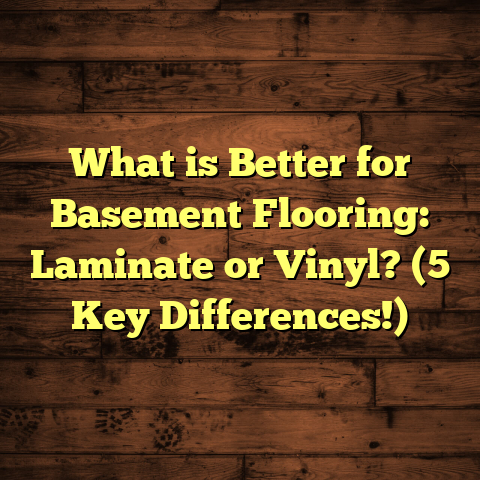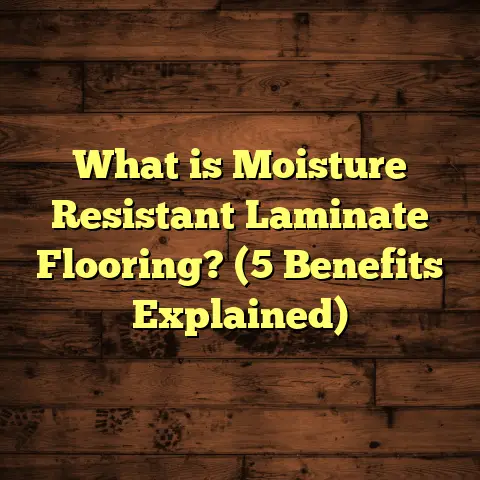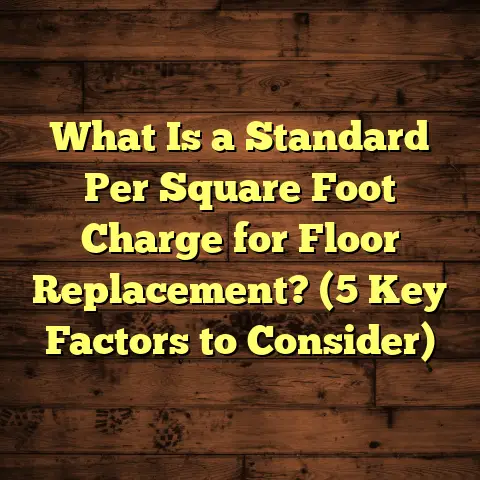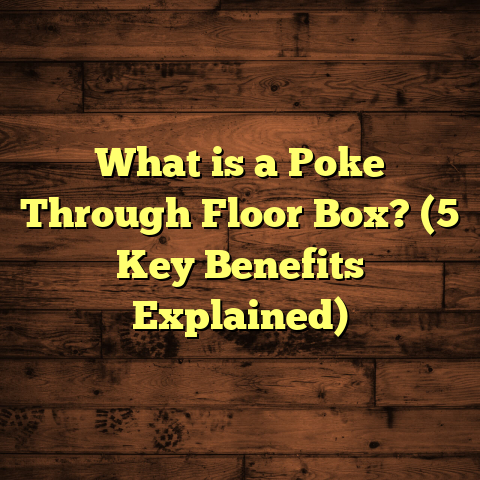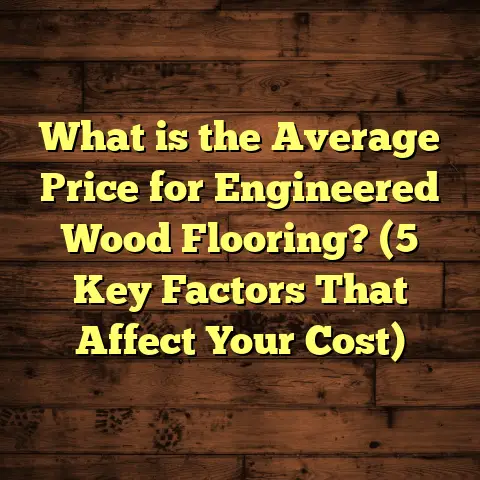What is Wood Flooring Called? (5 Types You Should Know!)
Discovering the Hidden Benefits of Wood Flooring
When I first started working with wood flooring, I quickly noticed that its appeal goes far beyond just looking good underfoot. Wood floors come with a host of hidden benefits that often surprise homeowners. For instance, did you know that wood flooring can actually help improve indoor air quality? Unlike carpets, which trap dust, pollen, pet dander, and other allergens, wood floors are much easier to keep clean and don’t hold onto those particles. This can make a real difference for people with allergies or asthma.
But that’s not all. Wood flooring has this amazing ability to make a space feel warmer and more inviting without adding physical warmth. It creates a natural aesthetic that other flooring materials just can’t match. And from a financial standpoint, wood floors often increase the resale value of your home—sometimes recouping 70-80% of the initial investment, which is higher than many other types of flooring.
Let me share a story. Early in my career, I worked with a family who was hesitant about investing in hardwood. They thought carpet was cheaper and easier. But after I explained these hidden benefits, especially the health advantages and longevity, they decided to go for solid hardwood. Years later, they told me their home felt healthier and more comfortable, and they were thrilled when their property value increased during resale.
So before you think about how wood flooring looks or feels, remember these less obvious benefits. They add up over time and can save you money and hassle down the road.
What Is Wood Flooring?
Wood flooring simply refers to any floor made from timber or wood products. But that’s where the simplicity ends because wood flooring comes in several different forms and constructions — each with its own characteristics.
At the core, wood flooring is about bringing the natural beauty and durability of wood into your living spaces. The most common types you’ll hear about are solid hardwood and engineered hardwood. However, there are also laminate floors that mimic wood and other variations like bamboo or reclaimed wood.
Why Different Types Matter
You might wonder why we have so many different kinds of wood floors. From my experience, it boils down to factors like:
- Durability: Some floors handle wear better than others.
- Moisture resistance: Some woods are better suited for damp environments.
- Installation: Some require professional installation while others can be DIY.
- Budget: Prices vary widely.
- Aesthetic preferences: Grain patterns, colors, plank widths differ.
Understanding these differences helps you pick a floor that fits your exact needs. For example, if your basement tends to be humid, solid hardwood may warp, but engineered hardwood would work fine.
5 Types of Wood Flooring You Should Know
I’ll walk you through the five main types of wood flooring I work with most often. I’ll share what makes each unique along with some real-world insights from my projects.
1. Solid Hardwood Flooring
Solid hardwood flooring is 100% natural wood cut from a single piece of timber. These planks are usually about 3/4 inch thick and come in widths ranging from narrow strips to wide planks.
Why It’s Special
Solid hardwood is prized for its beauty and longevity. Because it’s all wood through and through, you can sand it down and refinish it multiple times — sometimes up to 10 or 12 times during its life. This means even if it gets scratched or worn over decades, you can restore it to like-new condition.
The variety of species available is huge — oak, maple, cherry, hickory, walnut — each with distinct grain patterns and colors. This lets you customize your floor’s look based on your style.
My Personal Experience
I installed solid hardwood in my own home about 15 years ago. At first, I was worried about scratches from my dogs and kids running around. But after two refinishing sessions over the years, it looks almost brand new again. The natural aging process added warmth and richness that makes the floors feel truly lived-in and cozy.
Durability & Maintenance
Solid hardwood is tough but does require some care:
- Avoid excess water during cleaning to prevent warping.
- Use felt pads under furniture to prevent dents.
- Refinish every 7-10 years depending on wear.
Cost Breakdown
Solid hardwood tends to be pricier upfront due to material costs and installation complexity. On average:
- Material cost: $5-$10 per sq ft
- Installation: $3-$5 per sq ft
- Total installed cost: $8-$14 per sq ft
Professional installation is recommended since planks are nailed or stapled down over a wooden subfloor.
2. Engineered Hardwood Flooring
Engineered hardwood is a layered product: a thin veneer of real hardwood glued atop multiple layers of plywood or fiberboard arranged in a cross-grain pattern.
Why It Works Well
This construction makes engineered wood more dimensionally stable than solid hardwood. It resists expanding and contracting due to moisture changes better — making it suitable for rooms like basements and kitchens where moisture levels fluctuate.
You get the look and feel of real hardwood on top but with less risk of warping or cupping.
A Real Project Story
A couple I worked with wanted hardwood in their basement family room but were concerned about humidity causing damage. I recommended engineered hardwood as it combines beauty with better resistance to moisture fluctuations. Five years later, the floors still look fantastic without any signs of damage.
Installation Options
Engineered hardwood can be:
- Glued
- Nailed or stapled
- Floated (clicked together without nails/glue)
This versatility makes installation easier than solid hardwood in many cases.
Costs
Generally more affordable than solid hardwood:
- Materials: $4-$8 per sq ft
- Installation: $2-$4 per sq ft
- Total: $6-$12 per sq ft installed
3. Laminate Flooring
Laminate flooring isn’t made of wood but simulates wood’s appearance using a photographic layer protected by a durable wear layer above an HDF or MDF core.
Why People Like Laminate
Laminate is budget-friendly, scratch-resistant, and easy to maintain. It’s ideal for households with pets or kids where durability beats out authenticity for some homeowners.
You get a convincing wood look without the price tag or maintenance hassles of real wood.
My Observations
I suggested laminate for a young couple wanting stylish floors but needing something easy to clean since they had toddlers and pets. They appreciated how scratches didn’t show easily and how spills wiped up without staining.
Installation
Most laminate floors use a click-lock system that floats over existing floors or subfloors—no nails or glue needed—making it great for DIY projects.
Costs
Laminate is the most affordable option here:
- Materials: $1-$4 per sq ft
- Installation: $1-$2 per sq ft
- Total: $2-$6 per sq ft installed
4. Bamboo Flooring
Bamboo is technically grass but processed into planks similar to hardwood floors.
Why Bamboo?
It’s eco-friendly (bamboo grows quickly) and surprisingly hard—some species surpass oak in durability. It has a unique grain pattern giving your floor an exotic look.
My Experience with Bamboo
A client interested in sustainability chose bamboo for their living room floor. They loved knowing their floor was renewable and still got the hardness needed for daily life with kids and pets.
Bamboo does require attention to moisture levels; it can swell if exposed to water over time but is generally quite stable indoors.
Pricing
Bamboo falls between engineered hardwood and laminate in price:
- Materials: $4-$7 per sq ft
- Installation: $2-$3 per sq ft
- Total: $6-$9 per sq ft installed
5. Reclaimed Wood Flooring
This type takes salvaged wood from old barns, factories, or warehouses and repurposes it into flooring planks.
What Makes It Unique?
Each plank tells a story — weathering marks, nail holes, color variations add character impossible to replicate with new wood.
It’s also eco-conscious since it reuses materials that might otherwise be discarded.
A Memorable Project
I sourced reclaimed oak for a historic farmhouse renovation. The reclaimed floor added authenticity and charm that impressed visitors while preserving history and reducing environmental impact.
Cost Considerations
Reclaimed wood can be pricier due to sourcing challenges:
- Materials: $7-$12 per sq ft
- Installation: $3-$5 per sq ft
- Total: $10-$15 per sq ft installed
Deep Dive Into Wood Species & Grain Patterns
Choosing the type of wood species affects not only appearance but performance too.
Common Species & Traits
| Species | Hardness (Janka) | Grain Description | Color Range | Typical Use |
|---|---|---|---|---|
| Oak | 1290 | Prominent grain | Light to medium brown | Classic hardwood |
| Maple | 1450 | Fine grain | Pale cream | Sleek modern look |
| Cherry | 950 | Smooth grain | Reddish brown | Elegant interiors |
| Hickory | 1820 | Varied grain | Light to dark brown | High durability |
| Walnut | 1010 | Straight grain | Dark chocolate brown | Luxurious floors |
Janka hardness measures how resistant wood is to dents and wear.
Knowing this helps pick woods for high traffic areas (like hickory) versus decorative rooms (like cherry).
Wood Flooring Installation Tips From My Experience
Installing wood flooring may seem straightforward but small mistakes can cost big later on.
Preparing Your Subfloor
A flat, clean subfloor is critical. Uneven surfaces lead to squeaks or gaps later.
Acclimate Your Wood First
Wood expands/contracts based on humidity and temperature so give it time (usually 3-5 days) inside your home before installation.
Choose the Right Tools & Fasteners
Using proper nails/staples prevents damage during installation.
Maintenance & Care Insights That Save You Money
From my years on job sites and homeowner feedback:
- Sweep/vacuum regularly to avoid grit scratching finish.
- Use damp mop with pH-neutral cleaner designed for wood.
- Avoid harsh chemicals.
- Immediately wipe spills.
- Use rugs in high traffic zones.
- Refinish every few years depending on wear.
Cost Estimation & Budgeting: How FloorTally Helps Me Every Time
Budgeting for flooring projects used to take hours of manual calculations until I found FloorTally. This tool allows me to enter room size, pick material types (solid hardwood through laminate), add local labor rates, and even include waste percentages common in cutting planks.
This has helped me:
- Provide clients accurate estimates quickly
- Avoid surprises around extra material needs
- Compare costs between multiple flooring options side-by-side
- Plan budgets realistically without guesswork
For example, one recent job involved comparing solid oak vs engineered maple for 1,000 sq ft space. FloorTally showed total costs within 10% difference factoring labor/waste — helping clients confidently pick engineered maple for better moisture resistance at lower cost.
Comparing Wood Flooring Types Side by Side
Here is an extended comparison table covering more aspects:
| Type | Durability | Moisture Resistance | Cost (Installed) | Maintenance | Eco-Friendly | Longevity (Years) | Refinishing Potential |
|---|---|---|---|---|---|---|---|
| Solid Hardwood | High | Low | $8 – $14/sq ft | Moderate; needs refinishing | Medium | 50+ | Up to 12 times |
| Engineered Hardwood | Moderate-High | Moderate | $6 – $12/sq ft | Lower; fewer refinishing times | Medium | 20-30 | 2-3 times |
| Laminate | Moderate | Moderate-Low | $2 – $6/sq ft | Very low; no refinishing | Low | 10-20 | None |
| Bamboo | High | Moderate | $6 – $9/sq ft | Moderate | High | 30+ | Limited |
| Reclaimed Wood | High | Low | $10 – $15/sq ft | Moderate; like solid hardwood | Very High | 50+ | Up to 8 times |
Final Reflections on Choosing Wood Floors
Wood floors make homes feel alive—they tell stories through knots, grains, colors, and wear patterns over time. From installing my own solid hardwood floor to working on complex renovations with engineered or reclaimed woods, I’ve seen firsthand how important it is to pick the right type based on your environment and lifestyle.
Thinking about cost? Tools like FloorTally have made my job simpler by helping me plan budgets accurately while educating clients along the way.
Have questions about which wood floor fits your home best? I’m here to share what I’ve learned after hundreds of installations—just ask!
